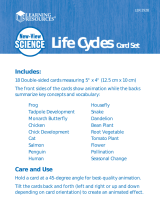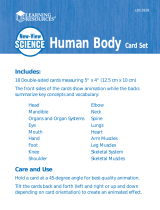Page is loading ...

The Monthly Calendar Pocket
Chart (LER 2210) is a fun and
graphic way to keep track of spe-
cial events and classroom cele-
brations! The chart can be used
by itself, or in conjunction with
Learning Resources’ Weekly
Pocket Chart (LER 2211).
Students will become more
organized as they follow the
classroom’s events on these easy-
to-read, decorative pocket charts!
The Monthly Calendar Pocket
Chart features one large and
forty-nine smaller, see-through
pockets for the Month, Days of
the Week and Date cards.
Month, and Days of the Week
cards feature English on one
side, and Spanish equivalents on
the other.
The chart also features three
reinforced grommets that make it
easy to hang in your classroom.
Cut out the supplied cards and
you're ready to get started!
What’s the Date?
Help younger students learn the
months and days of the week.
At the beginning of each month,
encourage students to make a
new calendar. Students will
learn the name of the new
month, how many days it has,
and on which days the month
begins and ends. This reinforces
their ability to find sequences
and patterns, plus bolsters their
counting skills!
Each day, challenge students to
find the date and place it in the
LER 2210
M
o
n
t
h
l
y
C
a
l
e
n
d
a
r
P
o
c
k
e
t
C
h
a
r
t
Teaching Guide
Keep Track and
Get Organized!
Use the Monthly Calendar Pocket Chart to organize your classroom.
Monitor returned papers, list special days, student’s tasks, or even dates
and deadlines for homework assignments! The extra pockets are great
for storing passes to the office, bathroom, and library!
Look for these and other fine products
also available from Learning Resources
®
:
LER 0504 Magnetic Learning Calendar
LER 2529 Spanish Alphabet Pocket Chart
LER 2573 Spanish Syllables Pocket Chart
© Learning Resources, Inc., Vernon Hills, IL (U.S.A.)
Learning Resources Ltd., King’s Lynn, Norfolk (U.K.)
Please retain our address for future reference.
Made in China.
Fabriqué en Chine. Informations à conserver.
Made in China. Bitte bewahren Sie unsere
Adresse für spätere Nachfragen auf.
Hecho en China. Conservar estos datos.
Visit our website to write a product review
or to find a store near you.

It’s Somebody’s Birthday!
Display students’birthdays on the
chart. Students will anxiously await
their birthday months to see a card
marking their special day! Other stu-
dents can make birthday cards for
their peers in their free time.
One Hundred!
Celebrate the one hundredth day of
the school year! Mark and count each
day as it passes. This will help your
students develop number sense, rein-
force counting skills, and expand
organization by keeping track of the
one hundred days!
When?
Introduce the concepts of yesterday,
today, and tomorrow, to reinforce
students’awareness of scheduled
events. Talk about the day after
tomorrow and the day before yester-
day. Challenge students to solve
problems such as: Yesterday was
Tuesday, the day after tomorrow is
Friday, what day was the day before
yesterday?
Science:
Phases of the Moon
Discuss the creation of the
calendar and its correspondence
to the phases of the moon. Ask
your students to look at the moon
each night. Track its phases.
Challenge your students to
explain why the moon’s phases
do not match the days of the
months. Draw diagrams
demonstrating the orbiting paths
of the moon, sun, and the earth
and the time it takes to complete
each cycle. This will show
students why the calendar does
not match the phases of the moon.
Classroom Management
Keep track of your students’
daily behavior by putting stars on
the days when your students’
behavior is at its best. Challenge
students to make twenty stars on
each calendar. If your students
meet your challenge, reward
them with a celebration! Next
month, make your challenge
more difficult. Try for twenty-
two stars!
large see-through pocket. A
sample date on your calendar
may read: Wednesday, February
1, 1995. Encourage students to
practice writing full dates and
headings. This will help them
understand the patterns and
relationships on the monthly
calendar.
Holidays
Encourage students to develop
sequencing skills with holidays!
Learning the months, seasons,
weeks, and days is a difficult
task for younger students.
First, use holidays to describe
seasons, then move to months.
More advanced students can
grasp sequences with holiday
weeks.
Current Events
Your pocket chart can be used as
a cross-curricular center! Have
students bring in newspaper clip-
pings of world events or activi-
ties in the community. Insert the
clippings in the see-through
pockets. Students can research
interesting topics and write jour-
nal entries. Make connections to
your science, reading, math, or
social studies curriculum!
Counting Down
You can help students develop an
awareness of time durations.
Mark each day as it passes. Help
students develop an awareness of
time duration for specific peri-
ods. A special event may be two
weeks away. Mark off a two
week block and count down the
days until you reach the event.
Younger students will quickly
grasp this idea. It also helps you
reinforce counting skills!
New Ways to Say
Use your Monthly Calendar Pocket
Chart to teach students a new lan-
guage! Start with the names of the
months and days of the week. The
cards included with this chart are in
English and Spanish. Display the
English version, then show students
the Spanish translations or vice versa.
Discuss the similarities in the lan-
guages and the words. Place a new
word on display for each day of the
month!
/













